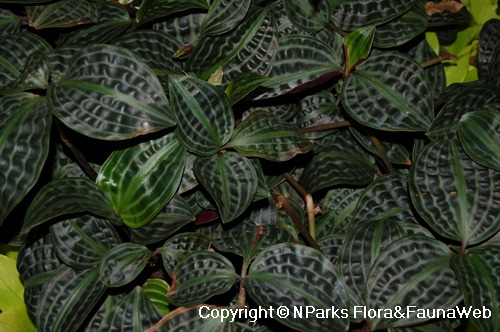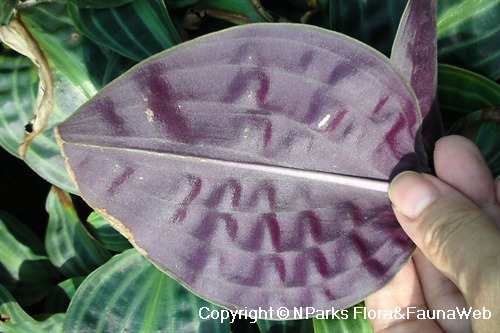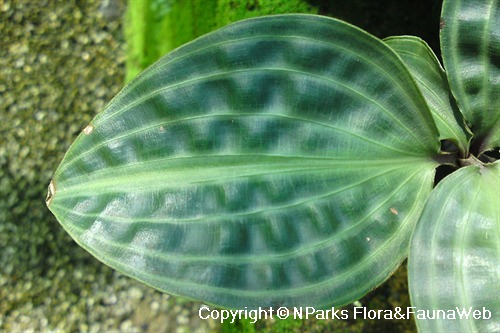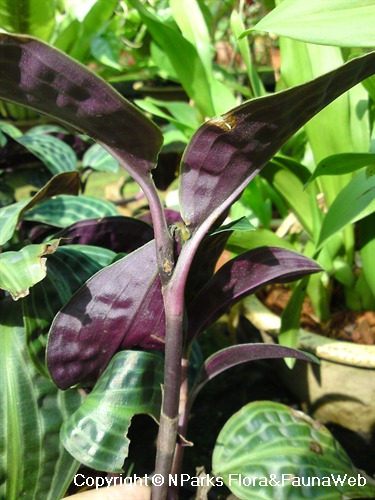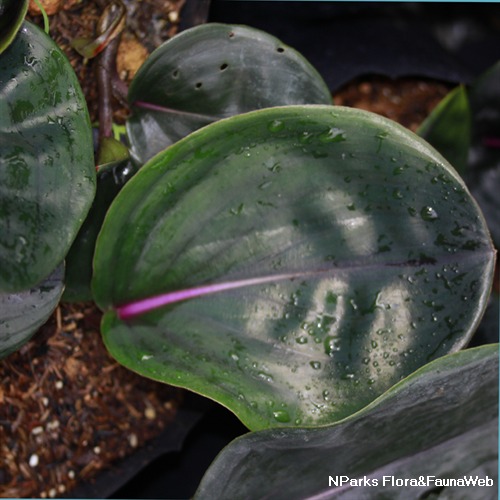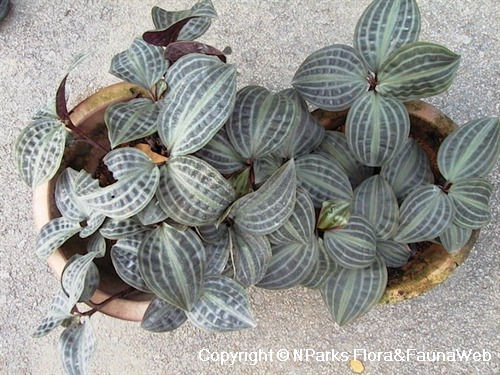
Back
Geogenanthus poeppigii
| Family Name: | Commelinaceae |
| Synonyms: | Uleopsis wittianus, Geogenanthus wittianus, Chamaeanthus wittianus, Dichorisandra undata, Dichorisandra musaica var. undata, Geogenanthus undatus |
| Common Name: | Seersucker Plant, 銀波草 |
Name
Classifications and Characteristics
| Plant Division | Angiosperms (Flowering Seed Plants) (Dicotyledon) |
|---|---|
| Plant Growth Form | Herbaceous Plant |
| Lifespan (in Singapore) | Perennial |
| Maximum Height | 0.25 m |
Biogeography
| Native Distribution | Peru, Brazil |
|---|---|
| Native Habitat | Terrestrial (Primary Rainforest) |
| Preferred Climate Zone | Tropical |
Description and Ethnobotany
| Others - Plant Morphology | Growth Form: A creeping or trailing plant that produces abundant suckers. Habitat: Occurs in the Amazon rainforests. Foliage: Leaves are fleshy, elliptic to ovate (8 - 13 cm long, 5 - 10 cm wide). Leaf texture is not flat, but rippled. The top is dark green with silver / grey stripes parallel to the midvein, while the bottom is dark reddish purple. Flowers: Flowers have 3 small petals with fringed edges (1.5 cm wide) and last only one day. Landscaping: This species may be planted underneath specimen trees. In humid climates, it may be used as a groundcover for shady locations. The variegated leaves help to brighten dark areas. It is also ideal for terrariums. Cultivation: This species is fast-growing. It will grow best in a humid environment, such as a terrarium, greenhouse or on top of a drywell (a tray of water and small rocks that raises the humidity around a plant, but prevents the soil from becoming waterlogged). Plant in a moisture retentive soil mix with good drainage and high humus content (eg., African violet potting mix). For potted plants, allow the top 1 cm of soil to dry before re-watering and feed biweekly with a half strength 15-15-15 NPK fertilizer. This species is resistant to most pests. Propagation: Propagate by seed, layering, stem cuttings or re-planting the suckers. Etymology: The genus "Geogenanthus" is derived from 3 Greek words that mean earth ("geos"), borne ("genus") and flower ("anthus"). The specific epithet "poeppigii" is named after E.F. Poeppig, a German explorer and professor of zoology (1798 - 1868). |
|---|
Landscaping Features
| Desirable Plant Features | Ornamental Foliage |
|---|---|
| Landscape Uses | Container Planting, Terrarium, Suitable for Hanging Baskets, Interiorscape/ Indoor Plant |
Plant Care and Propagation
| Light Preference | Semi-Shade, Full Shade |
|---|---|
| Water Preference | Moderate Water, Occasional Misting |
| Plant Growth Rate | Fast |
| Rootzone Tolerance | Fertile Loamy Soils, Well-Drained Soils |
| Propagation Method | Seed, Stem Cutting, Sucker, Air-Layering |
Foliar
| Mature Foliage Colour(s) | Green, Silver / Grey |
|---|---|
| Mature Foliage Texture(s) | Glossy / Shiny |
| Foliar Type | Simple / Unifoliate |
| Foliar Arrangement Along Stem | Whorled |
| Foliar Shape(s) | Non-Palm Foliage (Ovate) |
| Foliar Venation | Parallel |
| Foliar Margin | Entire - Wavy / Undulate |
| Foliar Apex - Tip | Acute |
| Foliar Base | Rounded / Obtuse |
| Typical Foliar Area | Notophyll ( 20.25cm2 - 45 cm2 ) |
| Leaf Area Index (LAI) for Green Plot Ratio | 3.5 (Shrub & Groundcover - Monocot) |
Non - Foliar and Storage
| Stem Type & Modification | Herbaceous |
|---|
Floral (Angiosperm)
| Flower Colour(s) | Purple |
|---|
Image Repository
Others
| Master ID | 734 |
|---|---|
| Species ID | 2029 |
| Flora Disclaimer | The information in this website has been compiled from reliable sources, such as reference works on medicinal plants. It is not a substitute for medical advice or treatment and NParks does not purport to provide any medical advice. Readers should always consult his/her physician before using or consuming a plant for medicinal purposes. |

